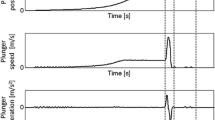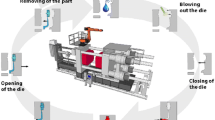Abstract
High-pressure die casting is a process widely used to manufacture components with high productivity and dimensional accuracy. Its main disadvantage is the high percentage of scraps, due to a high amount of defects. Thus, the identification of the parameters affecting quality of castings is the current challenge towards an efficient and effective production. In their previous work, the authors have found and statistically validated a novel parameter explaining and forecasting both static mechanical properties and porosity of castings. Such a parameter, defined as the root mean square value of the plunger acceleration in the fast shot stage, represents a measure of the average force transmitted by the plunger to the melt and has been proved to be very effective in predicting casting quality. In order to provide a practical tool for the use of this parameter, this work proposes an analytical method for its computation, starting from the plunger displacement curve or just some notable points. The method formulation takes advantage of the analytical development of the typical motion primitives adopted and also accounts for limitations due to the machine. Hence, the optimization of the process can be achieved by selecting in advance the most suitable plunger motion profile, among those feasible, that allows to improve the casting quality. Besides the theoretical formulation, a meaningful experimental validation is provided to demonstrate the correctness of the proposed parameter and of the analytical approach, as well as its ease of implementation that makes it suitable for industrial applications.
Similar content being viewed by others
References
Fiorese E, Bonollo F, Timelli G, Arnberg L, Gariboldi E (2015) New classification of defects and imperfections for aluminum alloy castings. Int J Met 9(1):55–66
Wang L, Turnley P, Savage G (2011) Gas content in high pressure die castings. J Mater Process Technol 211(9):1510–1515
Francis JA, Cantin GMD (2005) The role of defects in the fracture of an Al–Si–Mg cast alloy. Mater Sci Eng A 407(1):322–329
Chen LQ, Liu LJ, Jia ZX, Li JQ, Wang YQ, Hu NB (2013) Method for improvement of die-casting die: combination use of CAE and biomimetic laser process. Int J Adv Manuf Technol 68(9-12):2841–2848
Bonollo F, Gramegna N, Timelli G (2015) High-pressure die-casting: contradictions and challenges. JOM 67(5):901–908
Gunasegaram DR, Finnin BR, Polivka FB (2007) Melt flow velocity in high pressure die casting: its effect on microstructure and mechanical properties in an Al–Si alloy. Mater Sci Technol 23(7):847–856
Lumley R, Deeva N, Gershenzon M (2011) An evaluation of quality parameters for high pressure die castings. Int J Metal 5(3):37–56
Verran GO, Mendes RPK, Dalla Valentina LVO (2008) DOE applied to optimization of aluminium alloy die castings. J Mater Process Technol 200(1):120–125
Chiang KT, Liu NM, Tsai TC (2009) Modeling and analysis of the effects of processing parameters on the performance characteristics in the high pressure die casting process of Al–SI alloys. Int J Adv Manuf Technol 41(11-12):1076–1084
Cao Y, Guo Z, Xiong S (2012) Determination of the metal/die interfacial heat transfer coefficient of high pressure die cast B390 alloy. IOP Conf Ser Mater Sci Eng 33(1):012010
Fiorese E, Bonollo F, Battaglia E, Cavaliere G (2016) Improving die casting processes through optimization of lubrication. Int J Cast Met Res:1–7
Garber LW (1982) Theoretical analysis and experimental observation of air entrapment during cold chamber filling. Die Cast Eng 26(3):14–22
Zamora R, Faura F, López J, Hernández J (2007) Experimental verification of numerical predictions for the optimum plunger speed in the slow stage of a high-pressure die casting machine. Int J Adv Manuf Technol 33(3-4):266–276
Nikroo AJ, Akhlaghi M, Najafabadi MA (2009) Simulation and analysis of flow in the injection chamber of die casting machine during the slow shot stage. Int J Adv Manuf Technol 41(1-2):31–41
Hao J, Lin YJ, Nie Y (2015) CFD multiphase flow modelling of air porosity defect formation during high-pressure die-casting filling process. In ASME 2015 Int Mech Eng Congress and Exposition:V02BT02A012-V02BT02A012
Anglada E, Meléndez A, Vicario I, Arratibel E, Cangas G (2015) Simplified models for high pressure die casting simulation. Procedia Eng 132:974–981
Kittur JK, Patel GM, Parappagoudar MB (2016) Modeling of pressure die casting process: an artificial intelligence approach. Int J Met 10(1):70–87
Kittur JK, Choudhari MN, Parappagoudar MB (2015) Modeling and multi-response optimization of pressure die casting process using response surface methodology. Int J Adv Manuf Technol 77(1-4):211–224
Hsu QC, Do AT (2013) Minimum porosity formation in pressure die casting by Taguchi method. Math Probl Eng 2013:1–9
Boydak Ö, Savaş M, Ekici B (2016) A numerical and an experimental investigation of a high-pressure die-casting aluminum alloy. Int J Met 10(1):56–69
Siegbert R, Yesildag N, Frings M, Schmidt F, Elgeti S, Sauerland H, Vroomen U (2015) Individualized production in die-based manufacturing processes using numerical optimization. Int J Adv Manuf Technol 80(5-8):851–858
Fiorese E, Bonollo F (2016) Plunger kinematic parameters affecting quality of high-pressure die-cast aluminum alloys. Metall Mater Trans A. doi:10.1007/s11661-016-3522-7, in press
Dour G, Dargusch M, Davidson C, Nef A (2005) Development of a non-intrusive heat transfer coefficient gauge and its application to high pressure die casting: effect of the process parameters. J Mater Process Technol 169(2):223–233
Wu S, Xie L, Zhao J, Nakae H (2008) Formation of non-dendritic microstructure of semisolid aluminum alloy under vibration. Scr Mater 58(7):556–559
Jiang JF, Ying WANG, Qu JJ (2014) Effect of process parameters on microstructure and properties of AM50A magnesium alloy parts formed by double control forming. Trans Nonferrous Metals Soc China 24(2):321–333
Gasparetto A, Boscariol P, Lanzutti A, Vidoni R (2012) Trajectory planning in robotics. Math Comput Sci 6(3):269–279
Caracciolo R, Richiedei D (2014) Optimal design of ball-screw driven servomechanisms through an integrated mechatronic approach. Mechatronics 24(7):819–832
Richiedei D (2012) Synchronous motion control of dual-cylinder electrohydraulic actuators through a non-time based scheme. J Control Eng Appl Inform 14(4):80–89
Cleary PW, Ha J, Prakash M, Nguyen T (2010) Short shots and industrial case studies: understanding fluid flow and solidification in high pressure die casting. Appl Math Model 34(8):2018–2033
PD CEN/TR 16748:2014 Aluminium and aluminium alloys. Mechanical potential of Al-Si alloys for high pressure, low pressure and gravity die casting
Author information
Authors and Affiliations
Corresponding author
Rights and permissions
About this article
Cite this article
Fiorese, E., Richiedei, D. & Bonollo, F. Improving the quality of die castings through optimal plunger motion planning: analytical computation and experimental validation. Int J Adv Manuf Technol 88, 1475–1484 (2017). https://doi.org/10.1007/s00170-016-8875-y
Received:
Accepted:
Published:
Issue Date:
DOI: https://doi.org/10.1007/s00170-016-8875-y




